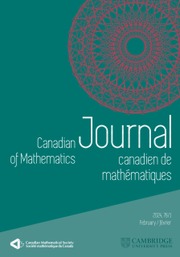No CrossRef data available.
Article contents
A criterion for the simple normality of fractional powers of two via the Riemann zeta function
Published online by Cambridge University Press: 29 May 2025
Abstract
A real number is simply normal to base b if its base-b expansion has each digit appearing with average frequency tending to  $1/b$. In this article, we discover a relation between the frequency at which the digit
$1/b$. In this article, we discover a relation between the frequency at which the digit  $1$ appears in the binary expansion of
$1$ appears in the binary expansion of  $2^{p/q}$ and a mean value of the Riemann zeta function on vertical arithmetic progressions. In particular, we show that
$2^{p/q}$ and a mean value of the Riemann zeta function on vertical arithmetic progressions. In particular, we show that  $$\begin{align*}\lim_{l\to \infty} \frac{1}{l}\sum_{0<|n|\leq 2^l } \zeta\left(\frac{2 n\pi i}{\log 2}\right) \frac{e^{2n\pi i p/q} }{n} =0 \end{align*}$$
$$\begin{align*}\lim_{l\to \infty} \frac{1}{l}\sum_{0<|n|\leq 2^l } \zeta\left(\frac{2 n\pi i}{\log 2}\right) \frac{e^{2n\pi i p/q} }{n} =0 \end{align*}$$ $2^{p/q}$ is simply normal to base
$2^{p/q}$ is simply normal to base  $2$.
$2$.
Information
- Type
- Article
- Information
- Copyright
- © The Author(s), 2025. Published by Cambridge University Press on behalf of Canadian Mathematical Society
Footnotes
The first author was financially supported by JST SPRING, Grant Number JPMJSP2125. The second author was financially supported by JSPS KAKENHI Grant Number JP22J00025 and JP22KJ0375.


